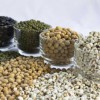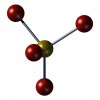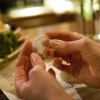 El potasio es un mineral que se encuentra dentro de las células del cuerpo. Es uno de algunos minerales conocidos como electrolitos. Estos minerales (potasio, sodio y cloro) se encuentran en los fluidos dentro y fuera de las células del cuerpo. This 2-page fact sheet is the Spanish language version of Facts about Potassium written by R. Elaine Turner and Linda B. Bobroff, and published by the UF Department of Family Youth and Community Sciences, February 2015.
El potasio es un mineral que se encuentra dentro de las células del cuerpo. Es uno de algunos minerales conocidos como electrolitos. Estos minerales (potasio, sodio y cloro) se encuentran en los fluidos dentro y fuera de las células del cuerpo. This 2-page fact sheet is the Spanish language version of Facts about Potassium written by R. Elaine Turner and Linda B. Bobroff, and published by the UF Department of Family Youth and Community Sciences, February 2015.
http://edis.ifas.ufl.edu/fy1214
Tag: Minerals (en espanol)
Datos sobre el fosforo
 El fósforo es un mineral que se encuentra en todas las células del cuerpo, por lo general en forma de fosfato. Es el segundo mineral más abundante en el cuerpo después del calcio. Alrededor del 85% del fósforo se almacena en los huesos y dientes. Es importante para la formación de huesos y dientes, además de la reparación de huesos.
El fósforo es un mineral que se encuentra en todas las células del cuerpo, por lo general en forma de fosfato. Es el segundo mineral más abundante en el cuerpo después del calcio. Alrededor del 85% del fósforo se almacena en los huesos y dientes. Es importante para la formación de huesos y dientes, además de la reparación de huesos.
This 3-page fact sheet was written by Nancy J. Gal y Wendy J. Dahl, and published by the UF Department of Food Science and Human Nutrition, August 2014.
http://edis.ifas.ufl.edu/fs252
Datos sobre los minerales (FCS8809S/FY1341)
 Los minerales son substancias como el calcio, el fósforo, el hierro y el zinc que se encuentran en las rocas y la tierra. También, se necesitan para tener una nutrición adecuada. Hay 16 minerales diferentes que sabemos que son necesarios en nuestra dieta. Varios otros minerales pueden ser necesarios en cantidades pequeñas. This 4-page fact sheet was written by R. Elaine Turner y Wendy J. Dahl, and published by the UF Department of Family Youth and Community Sciences, November 2012.
Los minerales son substancias como el calcio, el fósforo, el hierro y el zinc que se encuentran en las rocas y la tierra. También, se necesitan para tener una nutrición adecuada. Hay 16 minerales diferentes que sabemos que son necesarios en nuestra dieta. Varios otros minerales pueden ser necesarios en cantidades pequeñas. This 4-page fact sheet was written by R. Elaine Turner y Wendy J. Dahl, and published by the UF Department of Family Youth and Community Sciences, November 2012.
http://edis.ifas.ufl.edu/fy1341
Alimentación Saludable: El calcio (FCS8568Span/FY069)
El calcio es el mineral fundamental que se encuentra en nuestros huesos y dientes. Nosotros necesitamos calcio para el buen funcionamiento de los músculos y nervios. El calcio también ayuda para la coagulación de la sangre.
This 3-page fact sheet is the Spanish language version of FCS8568/FY068: Healthy Eating: Calcium Written by Linda B. Bobroff, and published by the UF Department of Family Youth and Community Sciences, January 2011.
http://edis.ifas.ufl.edu/fy069
Datos sobre el potasio (FCS8805Span/FY1214)
El potasio es un mineral que se encuentra dentro de las células del cuerpo. Es uno de algunos minerales conocidos como electrolitos. Estos minerales (potasio, sodio y cloruro) se encuentran en los fluidos dentro y fuera de las células del cuerpo.
This 2-page fact sheet is the Spanish language version of “Facts about Potassium” (FCS8805/FY889) Written by R. Elaine Turner and Linda B. Bobroff. Published by the UF Department of Family Youth and Community Sciences, January 2011.
http://edis.ifas.ufl.edu/fy1214
FCS8703Span/FY984 Datos sobre el calcio
FCS8703Span, a 3-page handout by Jennifer Hillan and Linda B. Bobroff, is the Spanish language version of FCS8703/FY216: Facts about Calcium . It answers common questions about calcium. Includes links to additional information. Published by the UF Department of Family Youth and Community Sciences, May 2010.
http://edis.ifas.ufl.edu/fy984
FCS8810Span/FY1159 Datos sobre el magnesio
FCS8810Span, a 2-page illustrated fact sheet by Jennifer Hillan and Linda B. Bobroff, is the Spanish language version of FCS8810/FY1088: Facts about Magnesium. It summarizes key facts about magnesium’s role in human nutrition — why we need it, what happens if we don’t get enough, how much we need, how we can get enough, supplements, and how much is too much. Includes links to reliable nutrition information on the Web. Published by the UF Department of Family Youth and Community Sciences, May 2010.
http://edis.ifas.ufl.edu/fy1159